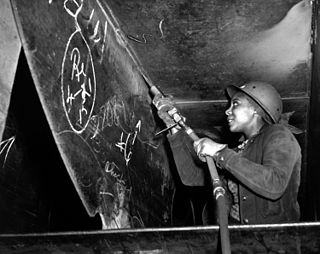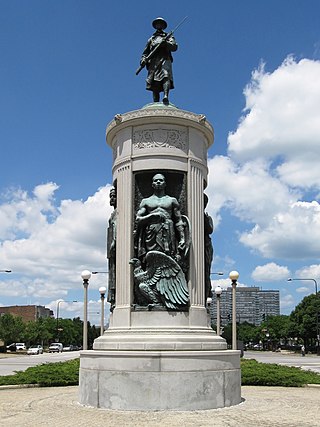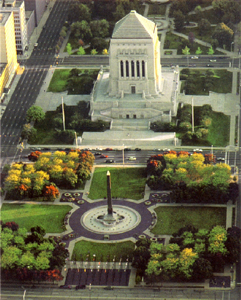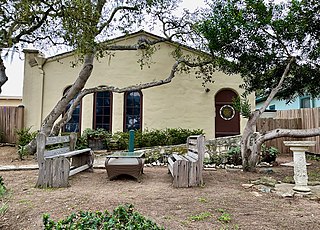
Gateway Arch National Park is an American national park located in St. Louis, Missouri, near the starting point of the Lewis and Clark Expedition.

Rosie the Riveter World War II Home Front National Historical Park is a United States national historical park located in Richmond, California, near San Francisco. The park preserves and interprets the legacy of the United States home front during World War II, including the Kaiser Richmond Shipyards, the Victory ship SS Red Oak Victory, a tank factory, housing developments and other facilities built to support America's entry into World War II. In particular, the role of women and African-Americans in war industries is explored and honored.

World War Memorial Stadium, more commonly known as War Memorial Stadium, is a baseball park in Greensboro, North Carolina, United States. It is situated on the northeast corner of Lindsay Street and Yanceyville Avenue, northeast of the downtown area and near the campus of North Carolina A&T University. It is currently the home of the NC A&T baseball team of the NCAA Division I Colonial Athletic Association (CAA).

The National World War I Museum and Memorial in Kansas City, Missouri was opened in 1926 as the Liberty Memorial. In 2004, it was designated by the United States Congress as the country's official war memorial and museum dedicated to World War I. A non-profit organization manages it in cooperation with the Kansas City Board of Parks and Recreation Commissioners. The museum focuses on global events from the causes of World War I before 1914 through the 1918 armistice and 1919 Paris Peace Conference. Visitors enter the exhibit space within the 32,000-square-foot (3,000 m2) facility across a glass bridge above a field of 9,000 red poppies, each representing 1,000 combatant deaths.

Erected in 1927, the Victory Monument, is a bronze and granite sculptural monument, based on a concept by John A. Nyden, and sculpted by Leonard Crunelle. It was built to honor the Eighth Regiment of the Illinois National Guard, an African-American unit that served with distinction in France during World War I. The memorial monument is located in the Black Metropolis-Bronzeville District in the Douglas community area on the South Side of Chicago, Illinois. The structure was added to the National Register of Historic Places on April 30, 1986. It was designated a Chicago Landmark on September 9, 1998. An annual Memorial Day ceremony is held at the monument.

Rosedale, Kansas is a community of Kansas City, Kansas, in the southeast corner of Wyandotte County and bordered on the north by the Kansas River and the Armourdale neighborhood, on the south by Johnson County, on the west by the Argentine neighborhood, and on the east by the state of Missouri. It is home to the Rosedale World War I Memorial Arch and the University of Kansas Medical Center.

The Indiana World War Memorial Plaza is an urban feature and war memorial located in downtown Indianapolis, Indiana, United States, originally built to honor the veterans of World War I. It was conceived in 1919 as a location for the national headquarters of the American Legion and a memorial to the state's and nation's veterans.

Central of Georgia Depot and Trainshed is a former passenger depot and trainshed constructed in 1860 by the Central of Georgia Railway (CofG) before the outbreak of the American Civil War. This pair of buildings was declared a National Historic Landmark in 1976, a listing that was expanded in 1978 to the old Central of Georgia Railway Savannah Shops and Terminal Facilities.

The World War I Memorial is a bronze sculpture by Pietro Montana and is located at the intersection of Taunton Avenue, Whelden Avenue, and John Street in East Providence, Rhode Island, United States. The sculpture is modeled on Charles Atlas and depicts a dynamically posed soldier standing on a granite base. Montana's original design was modified by the East Providence Memorial Committee for being "too brutal". Dedicated on July 30, 1927, Major General Charles Pelot Summerall gave an address which highlighted the handicap placed upon the soldiers by a lack of preparedness and "invoked the fighting ideal embodied by Montana's doughboy." The World War I Memorial was added to the National Register of Historic Places in 2001.

Memorial Hall, or Soldiers and Sailors Memorial Building, is a multi-purpose auditorium located in Kansas City, Kansas. The 3,500-seat auditorium, which has a permanent stage, is used for public assemblies, concerts and sporting events. It was listed on the National Register of Historic Places in 1985. It was designed by architects Rose & Peterson in Georgian style.
Linwood Boulevard is a boulevard and major east–west street in Kansas City, Missouri, United States. Linwood begins at Broadway Boulevard in the Valentine and Old Hyde Park neighborhoods and travels 3.8 miles east through Midtown to Van Brunt Boulevard near Interstate 70 in the Kansas City East Side. For much of its length, it creates a high-density corridor with 31st Street, another major street running parallel one block north. It continues west of Broadway Boulevard as 33rd Street past Metropolitan Community College-Penn Valley. Linwood Boulevard is one of the few named east–west streets in the Kansas City grid south of the Missouri River.
Memorial gates and arches are architectural monuments in the form of gates and arches or other entrances, constructed as a memorial, often dedicated to a particular war though some are dedicated to individuals. The function, and very often the architectural form, is similar to that of a Roman triumphal arch, with the emphasis on remembrance and commemoration of war casualties, on marking a civil event, or on providing a monumental entrance to a city, as opposed to celebrating a military success or general, though some memorial arches perform both functions. They can vary in size, but are commonly monumental stone structures combining features of both an archway and a gate, often forming an entrance or straddling a roadway, but sometimes constructed in isolation as a standalone structure, or on a smaller scale as a local memorial to war dead. Although they can share architectural features with triumphal arches, memorial arches and gates constructed from the 20th century onwards often have the names of the dead inscribed on them as an act of commemoration.

The Vox Theatre is an event space located in Rosedale, Kansas.

The 11th Street Bridge was completed in December 1915 to carry vehicles across the Arkansas River at Tulsa, Oklahoma. Used from 1916 to 1972, it was also a part of U.S. Route 66. Functionally, it has been replaced by the I-244 bridges across the Arkansas. As of 2009, the bridge was in poor structural condition and unsafe even for pedestrians. In 2008, the gates were locked to exclude all visitors.

The Pioneer and Military Memorial Park is the official name given to seven historic cemeteries in Phoenix, Arizona. The cemeteries were founded in 1884 in what was known as "Block 32". On February 1, 2007, "Block 32" was renamed Pioneer and Military Memorial Park. The Pioneer and Military Memorial Park is listed in the National Register of Historic Places. The historic Smurthwaite House, which is also listed in the National Register of Historic Places, is located on the grounds of the Pioneer and Military Memorial Park and is used as the cemetery's main office. Pioneer and Military Memorial Park is the final resting place of various notable pioneers of Arizona.

Sierra Madre Memorial Park is a historic landmark park in Sierra Madre, California. The public park is dedicated to Sierra Madre residents who have served in the U.S. Armed forces. The park has monuments, a band shell, tennis court, playground, covered picnic area and a historic house, called the park house, that is a historic landmark. The park is on Sierra Madre Boulevard and Hermosa, next to City Hall.

The Capitol Boulevard Memorial Bridge, also known as the Oregon Trail Memorial Bridge, is a historic bridge over the Boise River in Boise, Idaho, United States. It is listed on the National Register of Historic Places.

The American Legion Post No. 512 is a war veterans' organization and historic meeting hall located at the corner of Dolores Street and 8th Avenue in Carmel-by-the-Sea, California. The Legion Hall is open to all members of The American Legion. The Alvin B. Chapin Memorial Hall is used for special events and civic functions. The building was registered with the California Register of Historical Resources on January 28, 2002.

The Carmel-by-the-Sea World War I Memorial Arch is a World War I memorial designed in 1919 by architect Charles Sumner Greene and located at Ocean Avenue and San Carlos Street center median divider in Carmel-by-the-Sea, California. The Memorial Arch was designated as a significant monument in the city's Downtown Historic District Property Survey, The Memorial Arch was recorded with the Department of Parks and Recreation on November 16, 2001. The Memorial Arch has been a historic landmark since November 1921, when it was built for Carmel World War I veterans. The Spanish Mission Revival style arch is constructed of Carmel sandstone.

















